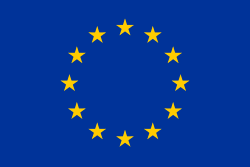Europeiska unionens stridsgrupper
Europeiska unionens stridsgrupper (från det engelska namnet European Union Battlegroups, EU BG), alternativt Europeiska unionens snabbinsatsstyrkor är militära snabbinsatsstyrkor som hålls i beredskap av Europeiska unionens medlemsstater.[1][2] Respektive stridsgrupp står i beredskap under sex månader, och två stridsgrupper finns i beredskap åt gången, med början i januari 2007. Vissa stridsgrupper tillhandahålls av en enskild medlemsstat, och andra är sammansatta av bidrag från flera olika medlemsstater. De insatsstyrkor som står i beredskap, ska kunna påbörja att lösa sina uppgifter i konfliktområdet inom tio dagar efter beslut om insats. Planerad insatsradie är inledningsvis upp till 6 000 km från Bryssel. Uthållighetstiden vid insats är satt till 30 dagar, men den ska kunna förlängas till upp till 120 dagar.
Lista över beredskapsperioder för olika stridsgrupper
| Period | Stridsgrupp | Ledningsansvar | Ledningscentral | |
|---|---|---|---|---|
| 2005 | Jan-juni | British Battlegroup | Storbritannien | London |
| French Battlegroup | Frankrike | Paris | ||
| Juli-dec | Italian Battlegroup | Italien | Rom | |
| Vakant | ||||
| 2006 | Jan-juni | French-German Battlegroup | ||
| Amphibious Battlegroup | Spanien | |||
| Juli-dec | French-German-Belgian Battlegroup | |||
| Vakant | ||||
| 2007 | Jan-juni | French - Belgian Battlegroup | Frankrike | Paris |
| Battlegroup 107 | Tyskland | Potsdam | ||
| Juli-dec | Italian-Hungarian-Slovenian Battlegroup | Italien | Rom | |
| Balkan Battlegroup | Grekland | Larissa | ||
| 2008 | Jan-jun | Nordic Battlegroup 08 | Sverige | London |
| Spanish-led Battlegroup | Spanien | |||
| Juli-dec | French-German based Battlegroup | Tyskland | Paris | |
| British Battlegroup | Storbritannien | London | ||
| 2009 | Jan-juni | Spanish Italian Amphibious Battlegroup | Italien | |
| Battlegroup Greece | Grekland | ? | ||
| Juli-dec | French Battlegroup | Frankrike | ? | |
| Battlegroup Belgium | Belgien | ? | ||
| 2010 | Jan-juni | Battlegroup I-2010 | Polen | Warszawa |
| UK-Dutch Battlegroup | Storbritannien | |||
| Juli-dec | Italian-Romanian-Turkish Battlegroup | Italien | ? | |
| Vakant | ||||
| 2011 | Jan-juni | Battlegroup 107 | Nederländerna | |
| Nordic Battlegroup 11 | Sverige | Enköping | ||
| Juli-dec | Eurofor | Portugal | Mont-Valérien | |
| Balkan Battlegroup | Grekland | Larissa | ||
| 2012 | Jan–juni | Frankrike, Belgien, Luxemburg | Frankrike | Mont-Valérien |
| ? | ? | ? | ||
| Juli–dec | Multinational Land Force | Italien | Rom | |
| Tyskland, Österrike, Tjeckien, Irland och Kroatien | Tyskland | Potsdam | ||
| 2013 | Jan–juni | Weimar Battlegroup (Polen, Tyskland, Frankrike) | Polen | Międzyrzecz |
| ? | ||||
| Juli–dec | 42 Battlegroup (Storbritannien, Lettland, Litauen, Nederländerna och Sverige) | Storbritannien | London | |
| ? | ? | ? | ||
| 2014 | Jan–juni | EU BG (Belgien, Nederländerna, Luxemburg, Spanien och Tyskland) [3] | Belgien | Leopoldsburg |
| ? | ? | ? | ||
| Juli–dec | ? | ? | ? | |
| ? | ? | ? | ||
| 2015 | Jan–juni | Nordic Battlegroup 15 (Sverige, Norge, Finland, Irland, Estland, Lettland och Litauen) [4][5] | Sverige | ? |
| ? | ? | ? | ||
| Juli–dec | ? | ? | ? | |
| ? | ? | ? | ||
Referenser
- ^ EU Concil Secretariat Factsheet - EU Battlegroups, November 2006
- ^ Gustav Lindstrom: Enter the EU Battlegroups Arkiverad 4 mars 2016 hämtat från the Wayback Machine., Chaillot Paper no. 97, Institute for Security Studies, February 2007
- ^ ”België leidt Europese interventiemacht in 2014” ((nederländska)). mil.be. Arkiverad från originalet den 10 juli 2013. http://archive.is/2013.07.10-164103/http://www.mil.be/def/news/index.asp?LAN=nl&ID=3745. Läst 10 juli 2013.
- ^ ”Nordic Battlegroup”. sakerhetspolitik.se. Arkiverad från originalet den 3 december 2013. https://web.archive.org/web/20131203121437/http://www.sakerhetspolitik.se/Forsvar/Internationellt/Nordic-Battle-Group/. Läst 10 juli 2013.
- ^ ”Beredda under brittisk ledning”. forsvarsmakten.se. https://www.forsvarsmakten.se/sv/aktuellt/2013/07/beredda-under-brittisk-ledning/. Läst 10 juli 2013.
| EU-portalen – temasidan för Europeiska unionen på svenskspråkiga Wikipedia. |
Media som används på denna webbplats
The Flag of Europe is the flag and emblem of the European Union (EU) and Council of Europe (CoE). It consists of a circle of 12 golden (yellow) stars on a blue background. It was created in 1955 by the CoE and adopted by the EU, then the European Communities, in the 1980s.
The CoE and EU are distinct in membership and nature. The CoE is a 47-member international organisation dealing with human rights and rule of law, while the EU is a quasi-federal union of 27 states focused on economic integration and political cooperation. Today, the flag is mostly associated with the latter.
It was the intention of the CoE that the flag should come to represent Europe as a whole, and since its adoption the membership of the CoE covers nearly the entire continent. This is why the EU adopted the same flag. The flag has been used to represent Europe in sporting events and as a pro-democracy banner outside the Union.